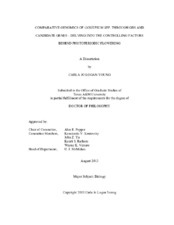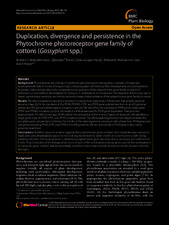| dc.description.abstract | Cotton has been a world-wide economic staple in textiles and oil production. There has been a concerted effort for cotton improvement to increase yield and quality to compete with non-natural man-made fibers. Unfortunately, cultivated cotton has limited genetic diversity; therefore finding new marketable traits within cultivated cotton has reached a plateau. To alleviate this problem, traditional breeding programs have been attempting to incorporate practical traits from wild relatives into cultivated lines. This incorporation has presented a new problem: uncultivated cotton hampered by photoperiodism.
Traditionally, due to differing floral times, wild and cultivated cotton species were unable to be bred together in many commercial production areas world-wide. This worldwide breeding problem has inhibited new trait incorporation. Before favorable traits from undomesticated cotton could be integrated into cultivated elite lines using marker-assisted selection breeding, the markers associated with photoperiod independence needed to be discovered. In order to increase information about this debilitating trait, we set out to identify informative markers associated with photoperiodism.
This study was segmented into four areas. First, we reviewed the history of cotton to highlight current problems in production. Next, we explored cotton’s floral development through a study of floral transition candidate genes. The third area was an in-depth analysis of Phytochrome C (previously linked to photoperiod independence in other crops). In the final area of study, we used Genotype-By-Sequencing (GBS), in a segregating population, was used to determine photoperiod independence associated with single nucleotide polymorphisms (SNPs).
In short, this research reported SNP differences in thirty-eight candidate gene homologs within the flowering time network, including photoreceptors, light dependent transcripts, circadian clock regulators, and floral integrators. Also, our research linked other discrete SNP differences, in addition to those contained within candidate genes, to photoperiodicity within cotton. In conclusion, the SNP markers that our study found may be used in future marker assisted selection (MAS) breeding schemas to incorporate desirable traits into elite lines without the introgression of photoperiod sensitivity. | en |



